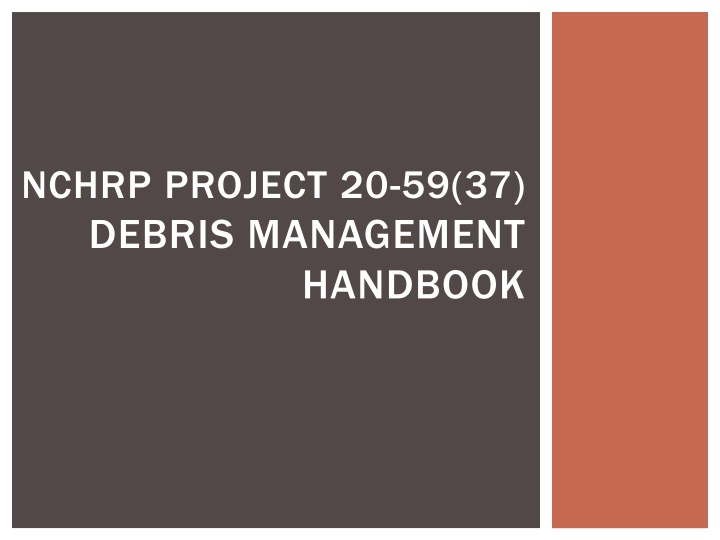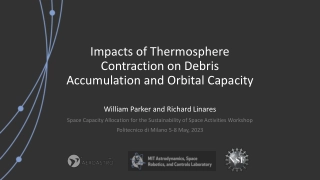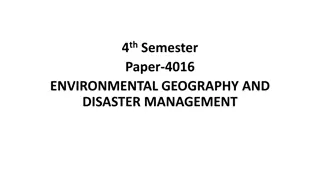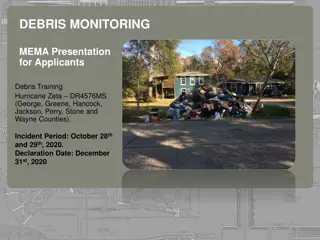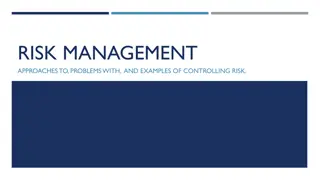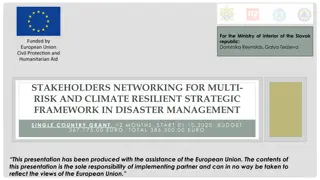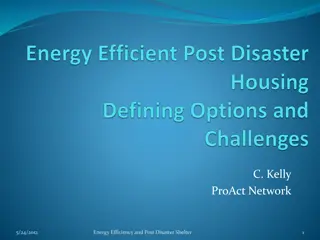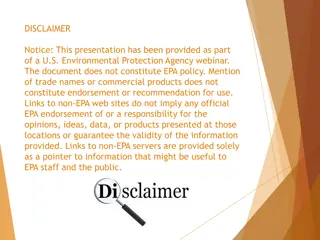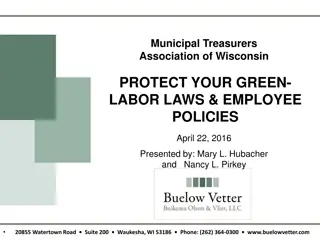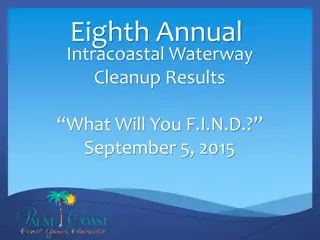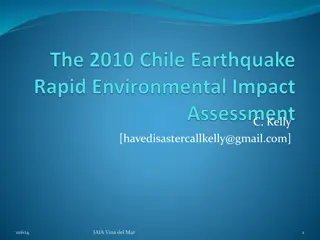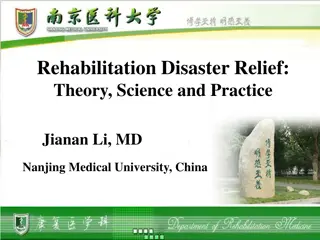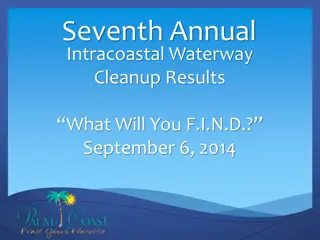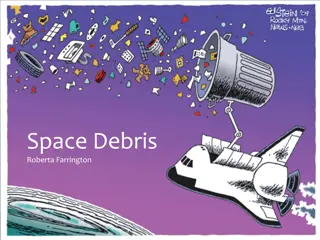Debris Management Handbook: Comprehensive Guide for Post-Disaster Cleanup
This handbook aims to provide state and local staff with a practical guide for managing debris after disasters. It covers crucial aspects such as debris issues, project overview, research plan, methodology, literature database, and general conclusions. By synthesizing information from various databases and experts, the handbook helps prioritize actionable strategies for effective debris management.
Download Presentation

Please find below an Image/Link to download the presentation.
The content on the website is provided AS IS for your information and personal use only. It may not be sold, licensed, or shared on other websites without obtaining consent from the author.If you encounter any issues during the download, it is possible that the publisher has removed the file from their server.
You are allowed to download the files provided on this website for personal or commercial use, subject to the condition that they are used lawfully. All files are the property of their respective owners.
The content on the website is provided AS IS for your information and personal use only. It may not be sold, licensed, or shared on other websites without obtaining consent from the author.
E N D
Presentation Transcript
NCHRP PROJECT 20-59(37) DEBRIS MANAGEMENT HANDBOOK
OUTLINE Debris Issues Project Overview Phase I Literature Review Field Review and Analysis Outline Phase II Case Studies Handbook Discussion
DEBRIS ISSUES Widespread Costly Immediacy
PROJECT OVERVIEW Objective Objective: Develop a comprehensive, actionable handbook for state and local staff tasked with post-disaster debris management. Target Audience: Target Audience: Local Departments of Transportation tasked with debris management
Method and Results PHASE I
APPROACH: IDENTIFYING PUBLICATIONS Databases: FEMA Library Transport Research International Documentation (TRID) Thomas (Library of Congress) Lessons Learned Information Sharing (LLIS) International Risk Management Institute (IRMI) ISI Web of Science Google Searches Recommendations from Field Survey Recommendations from Subject Matter Experts (SMEs) Note that only publicly available, English publications were reviewed.
APPROACH: EVALUATION Was the publication useful? Very Somewhat Not at all Was the publication actionable? Very Somewhat Informational, but not actionable Not informational or actionable This qualitative review helped prioritize use of publications for the handbook.
OUTCOME: LITERATURE DATABASE Filter on any criterion
GENERAL CONCLUSIONS Large amounts of duplicative information. Largest volume of information does not necessarily correspond to highest confidence among debris management staff. Many areas specific to disaster type (e.g. 9/11). Interagency coordination major theme of after action reports.
GOALS OF THE FIELD SURVEY 1. Identify trends and the state of the art of debris management among state and local staff. 2. Identify additional plans and publications for inclusion in the literature review. 3. Identify potential interviewees for expanded Case Studies to be developed.
SURVEY OUTREACH Transportation Research Board (TRB) state representatives International City/County Management Association (ICMA) American Public Works Association (APWA) Solid Waste Association of North America (SWANA) International Association of Emergency Managers (IAEM)
SURVEY RESPONDENTS BY GEOGRAPHY Responses were received from every FEMA region.
SURVEY RESPONDENTS BY ORGANIZATION TYPE Nearly 75% of respondents were from local entities.
DOCUMENTS AVAILABLE TO RESPONDENTS Fewer than half of respondents had debris management plans in place. Even fewer had policies or pre-positioned contracts.
EXPERIENCE IN DEBRIS MANAGEMENT The majority of respondents have participated in 5 or fewer debris management events. This could indicate a generational gap in debris management experience.
DEBRIS MANAGEMENT EXPERIENCE Policy, segregation, site selection, and reimbursement presented the greatest challenges to respondents.
HANDBOOK FORMAT One chapter for each phase, in chronological order Each chapter includes: Why Why is this phase important? What What does this phase entail? When When does this phase occur? Who Who is involved in this phase? How How does this phase happen? Each chapter also includes: A relevant case study, as available Resource list
HANDBOOK OUTLINE I. II. Planning III. Debris Estimating IV. Policy V. Contracts VI. Operations VII. Removal VIII.Segregation Introduction IX. Debris Management Site Selection X. Monitoring XI. Reduction and Disposal XII. Reimbursement XIII.Special Considerations XIV.More Information
Method and Results PHASE II
CASE STUDIES Based on list identified in Field Survey, call respondents around the country. Step 1: Team conducted preliminary (15-20 minute) phone interviews with potential case study contributors. Based on survey respondents, identify 2 local and 2 state from each region Step 2: Team SMEs conducted in-depth interviews by phone or in person with strongest contributors.
PRELIMINARY INTERVIEW OUTCOMES 21 preliminary interviews from 7 regions Preliminary Interviews Preliminary Interviews State, 8 Local Private State Local, 12 Private, 1
HANDBOOK DEVELOPMENT Chapters developed based on outline Subject Matter Expert input Additional chapters identified and drafted Graphics and tools developed
FINAL HANDBOOK The Debris Management Handbook should: Be the Go Go- -to resource to resource for state and local agencies to develop policies, plans, and operational procedures, including reimbursements, in matters related to Debris. Be a simple, easy simple, easy to read document that outlines a comprehensive debris management framework based on analysis of academic and applied research from national and international sources. Exemplify national best Exemplify national best- -practices practices on debris management for state and local agencies to develop insights into the implicit issues and challenges that could affect the best-laid out plans and help develop adequate mitigation strategies. Lay the foundation for development of comprehensive and coordinated debris management strategy coordinated debris management strategy that will enhance cooperation and participation between state and local stakeholders. comprehensive and
TARGET AUDIENCE The handbook is applicable to a wide variety of users that routinely encounter debris clearance, control, or removal issues. It is also attractive to academic research bodies like the National Academies of Science (NAS), and more specifically TRB, to conduct further research on specific areas outlined in the handbook. The handbook serves to identify effective practices to ensure maximum reimbursement from federal agencies associated with debris operations.
APPLICATION This handbook serves as a resource for preplanning to help direct documentation and administrative policies, training and exercises, a field guide to help direct debris operations and minimize impacts, and an accounting reminder to supervisors and administrative staff on the requirements of debris documentation for reimbursement. It also encourages cooperation and partnerships between different state and local agencies.
CONCLUSIONS The existing body of literature (as well as the additional documents suggested by the panel) served as an excellent starting point for a draft handbook. The field survey and case studies helped to focus the handbook development on real-world examples and areas in which local and state debris managers feel most challenged (especially policy, segregation, and reimbursement). The team was able to draw the best from existing publications and tools and identified new ways to present information to try to improve the understanding of lessons observed and effective practices associated with those phases.
